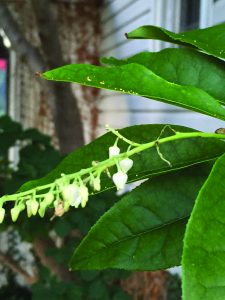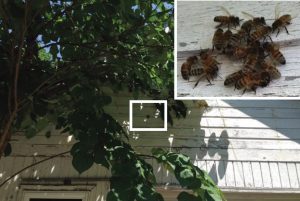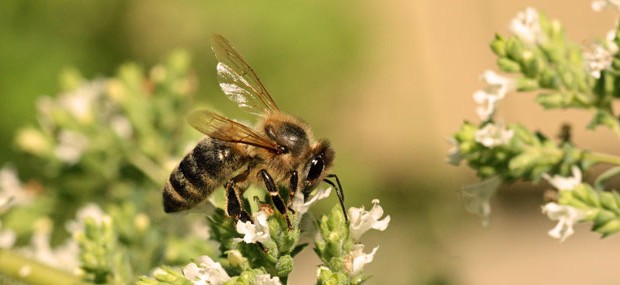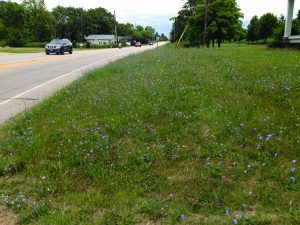 By: Kim Flottum
By: Kim Flottum
A peculiar thing is happening, relative to what is growing where anymore, at least in my part of Ohio, and in parts of several other states I’ve traveled in this Summer, including much of the mid and northeast.
What I’ve noticed is that birdsfoot trefoil (Lotus corniculatus L.)is taking over roadsides. There’s a photo below that shows what I’m talking about. Now I’m no birdsfoot expert, but I know it’s an invasive, and it does well in poorly drained, generally poor soil locations, which roadsides generally are. So that might be it. Maybe, in the last two or so years, highway departments are seeding roadsides with this stuff for erosion control and to keep other weeds down – it is quite competitive and will take over where it’s planted given the chance, and the European varieties (versus the Asian types), which these seem to be, are low growing and don’t need mowing, so it’s a win, win, win for highway maintenance people. Well, and beekeepers and pollinators, too. Bees and butterflies like this plant, and it’s pretty productive from a beekeeper’s view, providing there’s some rain to go with it. It’s a legume, so the pollen is pretty high in protein, it doesn’t have a lot of nectar per flower, but there are a lot of flowers on a plant, and when established the population gets pretty dense. One plant will expand to a rosette of about nine inches across, and about 3” – 5” tall with 30 – 50 blossoms on it, so it isn’t very tall, and doesn’t cause any visibility problems, yet covers a good chunk of land with – flowers. When grown as a pasture plant, in good soil with adequate moisture it will get a lot taller and makes a good forage plant for cattle, especially dairy cattle. It was used in northern Wisconsin for that years ago.
The photo shows that it is thriving, blooming and spreading where it is growing here in Ohio on roadsides, while the grass it is competing with is essentially dormant. It’s been dry here in NorthEast Ohio in July so this shows it does well when its competitors don’t.
So, that’s one. The other one is a bit less noticeable because it’s been around for so long. Chicory, (Cichorium intybus). You probably recognize it immediately. Roadsides, near-roadsides and other not-often mowed pastures and meadows. It, too is an invasive, and has spread to much of the U.S.
It blooms in mid to late Summer until frost or so, and has been around since colonial days. It shows up early on as a rosette, but in mid-summer sends up flower spikes and becomes very visible. Course, strong flower stems preclude it being removed easily so it stands, strong, tall and purple for the rest of the summer. Occasionally you will see a white flower, even less often a pink flower, but the purple is predominant. It’s a friend to bees and beekeepers. It’s not at the top of the list of bee plants, but it blooms in a lot of places when there’s nothing else at the end of the season.
Some report that it produces honey, but the quality isn’t well defined. I’ve watched bees on the flowers and have seen only pollen collection, but that might be a time of day thing, rather than no nectar. But the pollen is distinctive when you see it – white. I don’t know any other plant with such white pollen, especially this time of year.
But what’s curious to me is that there seems to be so much more of this plant growing this year than where it has always grown in past years. Of course I’m relying on memory, which is never a good thing, but there just seems to be more. Dense patches in lawns, like the photo, spreading far, far off the road, where it typically grows now far up into ditches and even lawns. And on the typical roadside stand, they seem to be denser, more plants per unit area than in the past.
Now part of this, I admit, is that it’s been a very dry June, July and early August here in northeast Ohio, and in some of the other locations I’ve seen this chicory phenomena. This simply means that all vegetation is growing slower and lawns and roadsides are stressed and not getting mowed as often letting these plants thrive. Chicory is, after all, a very drought tolerant plant so that would explain some of this I suppose.
And, the one trait invasives have in common is that, because of their special skills they out compete native plants for resources, space and attention. And that seems to be the case. So, two invasives doing well, helping bees and beekeepers, and looking good besides. Dare I say, win, win, win?
Ok, that’s two.
 Yet a third curious thing happened this past month. Look at the photo of the bees on the wall of my garage, above the door. A tiny, tiny bunch, with the blow-up showing them up close. No big deal, you think, right? Look closer at the bees. All workers. No drones, not a queen, just workers. They’re moving around a bit, back and forth, but not a washboard movement. One might fly off, and then one might join them – same bee returning? Can’t tell you that, but the number stays about the same, day after day after day – for three full weeks. Well, at least three weeks because that’s how long I watched them. I checked in for 21 days – I missed a few in between because I was gone, but they were there when I got back. Same bunch? don’t know. Nor do I know how long they were there before I started watching. It’s a pretty protected spot, with some tree foliage above them and a bit of overhang from the garage roof.
Yet a third curious thing happened this past month. Look at the photo of the bees on the wall of my garage, above the door. A tiny, tiny bunch, with the blow-up showing them up close. No big deal, you think, right? Look closer at the bees. All workers. No drones, not a queen, just workers. They’re moving around a bit, back and forth, but not a washboard movement. One might fly off, and then one might join them – same bee returning? Can’t tell you that, but the number stays about the same, day after day after day – for three full weeks. Well, at least three weeks because that’s how long I watched them. I checked in for 21 days – I missed a few in between because I was gone, but they were there when I got back. Same bunch? don’t know. Nor do I know how long they were there before I started watching. It’s a pretty protected spot, with some tree foliage above them and a bit of overhang from the garage roof.
No, there’s no entrance into the garage underneath them. And there’s no queen from a lost swarm hanging around, and there’s no glop of something to eat they’re hanging onto. Just a bunch of bees, hangin’ out on a garage wall. For three weeks.
There are two hives on the ground about 20 yards directly to the left of the garage from your perspective. One is going gangbusters, the other has lost four queens so far this Summer. Can’t keep one in there for reasons only they know, so maybe this is a rebel band, tired of the chaos inside and looking for some peace and quiet, out on a garage wall.
There’s two more hives another 20 yards away, directly behind where I’m standing taking the photo here, sitting on the front porch of the house. Both doing pretty good. So within 20 yards in two directions are four mostly full size hives, three doing quite well, one struggling and more queenless than not most of the summer.
So, given that, you got any idea why 20 or so bees would take up residence on the side of my garage for a few weeks? I’m thinkin’ it just ain’t that great a place to hang out.
•
OK, here’s a switch. Well, it’s moving toward a switch. I don’t think it’s in stone yet. And maybe it won’t be in the future.
Long ago, when we studied Integrated Pest Management, one of the things we learned was not to prophylactically treat a crop for a pest or disease. That is, you don’t spray apples for apple maggot just because it’s the first of June, when they usually start being a problem. Rather, you put up traps to see how many of them there are which will tell you how much damage they are bound to cause, and, when trap catches hit a certain level you treat so they don’t become a problem. Terms like economic threshold and economic injury level played into this, and if you were a smart farmer, you paid attention to those because it saved your crop, and it saved you money.
Enter Varroa as a pest of our crop, honey bees.
First, we treated when the adult population reached that threshold by measuring how many mites were on adult bees in a colony. We did this by counting how many fell off adult bees during a three day period. The sticky board was our yard stick.
Then, we figured out that the mites on adult bees were only a small per cent of the mites in a colony, so we refigured our treatment yard stick, and treated when the number on the sticky board was even smaller.
Next we figured a better way to measure and we went to the ether roll and then the alcohol wash, which measured all the mites on the adult bees in the sample we took. Capture 300 bees, put them in a jar, spray or soak them with ether or alcohol which kills the bees and the mites. Shake, rattle and roll for a bit and count the mites. Three mites would give you a 1% infestation rate of mites on adult bees. Again, assuming that way more mites were under cappings than on adults, the number of infested adults needed to be pretty low so that you got almost all the mites in the colony with the treatment and didn’t have to come back and do it again.
In the meantime, treatments got better, so we were killing the mites under cappings and if you paid attention to the details, you saved your bees, and saved money.
But at the same time, what the mites were doing kept getting nastier. They were spreading viruses like a cold in a classroom, and spreading more of them. And it turns out that once the viruses were in the hive infecting the bees, the bees in turn started infecting each other. And worse, these viruses caused bees to die younger, and younger and younger. So a beekeeper could measure mites, hit a per cent level of infection, treat, and still lose the colony because the viruses inside were running rampant and even without a mite in the hive the colony would die. And even worser, (more worse?, worestest?) as the colony was collapsing, the bees inside were abandoning hearth and home heading for better places to be than the death trap they were in, taking mites if there were any, and all their internal viruses with them, sharing the stench of death everywhere they went.
Add this one thing in. It ain’t natural to put five or 5000 beehives in the same place at the same time, is it? No, given a choice, much research has shown that a colony every square mile or so, in most places, works out best for everybody. These artificial gatherings we arrange make it easy for those abandoning bees to find a better place to live. No mites, no virus, a queen, lots of food. Not like what they just left.
Ok, so what. Because our bees do such a fine job of sharing what they have, doesn’t it stand to reason that if a single colony in a beeyard has reached some level of infestation requiring treatment – that is, a level that occurs before the mite population explodes, before the virus epidemic runs all over all the bees, before, before, before. This has reduced the treatment level to a fraction of a percent, but more, much more importantly, the thought is, treat everybody. Every colony in the bunch. Everybody. Now. Don’t wait for the next one to reach some magic level of infestation. The rule is, or is becoming, treat everybody, now, once a single colony reaches that tiny, tiny level of mite habitation.
We are, is seems, no longer looking at a colony as the organism, rather, we should be looking at the beeyard as the organism, whether five or 5000 colonies in the bee yard.
Lots of beekeepers have already been doing this. Why treat just one, they ask, I’m here, I’ll treat everybody…just in case. Well this isn’t such a bad idea it turns out…and it’s not the prophylactic treatment mindset we used to use when treating every colony in the beeyard for AFB, just so they won’t get it, and because I can.
IPM saves the crop and saves money, whether for apples, sweet corn or honey bee colonies. Saving the colony is saving you money. You have few choices. Use the best weapons you have, do the best that you can. This is war.
•
And finally, that shot at the top. That’s a blossom from a Sourwood tree, a member of the Lilly Of The Valley family. Nothing unusual about it really, except perhaps that the photo was taken in August, in Ohio, in my yard. I’ve got it in a protected spot, right next to the Bee Bee Tree, so it might just do OK where it is. I bought it at the Indiana meeting this spring from Rockbridge Trees. We’ll see how it goes, but if it does OK, next year I can say my honey is Sourwood Infused, and the price just went up.
•
September. National Honey Month, and we can see the end of a long, hot Summer. I’ve spent more time watering plants this year than maybe ever. Come on rain!










